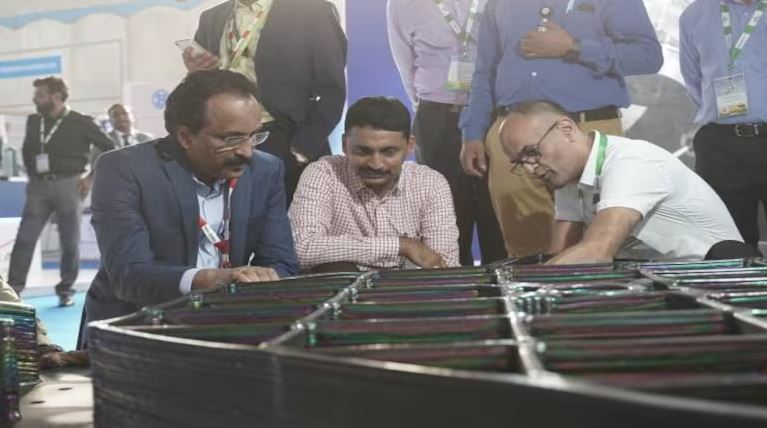Bengaluru-based Ankit Aerospace manufactured the prototype of a 3D- printed grid fin, a type of flight control surface to be used for the upcoming Gaganyaan or human spaceflight mission
Bengaluru-based Ankit Aerospace handed over the prototype of a 3D-printed grid fin, a type of flight control surface to be used for the upcoming Gaganyaan (human spaceflight) mission, to the Indian Space Research Organisation (ISRO) on February 13.
The grid fin was handed over to ISRO at the Aero India event in Bengaluru.
In the Gaganyaan mission, grid fins will be used in the crew module which will sit on top of the rocket. “In case there is an aborted launch, or if there is something wrong with the launch pad, the first priority is to secure the astronauts,” Ankit Patel, Founder of Ankit Aerospace said.
“Then, the crew module immediately separates from the rest of the rocket and it’s pushed 10-12 km in the air. The moment it goes up in the air, it has to come down safely. That is when the grid fin gets deployed, to provide aerodynamic stability and aerodynamic braking — so that the crew module does not spin out of control,” he added.
Where the 3D-printed grid fins differ from traditional casting-made ones (such as the ones used on SpaceX), is that it does not have any joints; it saves a lot of raw material (but also increases cost) and also reduces the time of production to a matter of weeks from months.
“The conventional way of making it is that you start with a 2.5-tonne titanium plate and finish with a part which is about 150 or 200 kg, thus generating 2,000 plus kg of scrap,” Patel said. With 3D printing, the company printed grid fins with titanium worth only 600 kg, saving 75 percent of material, he noted.

The company has been developing this grid fin for the last two years. Initially, it was supposed to deliver the product in early 2021, Patel said, but due to a shortage of titanium internationally, the production got delayed to 2023.
Multiple tests to be conducted
In the following months, Patel said multiple tests will have to be conducted for the Gaganyaan mission.
“The first worry about any 3D-printed part is whether it has the strength comparable to traditional material. For that we have to do a strength or tensile test,” he said.
Secondly, tests will also be conducted to check if there are any cracks or porosity in the 3D-printed material.
“This can be done after some post-printing processing which will start happening after we go live. ISRO will support us to do radiography or X-ray testing to check if there are cracks. Then we have to check whether the fracture toughness is there,” he added.
Fast production but significantly expensive
Despite the varied amount of benefits that 3D printing is beginning to show across various sectors, the fact remains that the technology is still very expensive.
Due to the high cost of the 3D printing equipment and scarcity of raw materials, the cost of production for the company was high, when compared to the cost of production of manufacturing grid fins using traditional technologies.
“We’ve had to absorb a lot of initial cost, and we cannot pass it through. It’s a hit if the technology succeeds. There will be benefits for us in the future as the costs will reduce; otherwise, this will not go ahead,” Patel said.
Due to the high price of the 3D printing equipment, the company had to manufacture the grid fin in the United States. “Our goal is to do a part ownership of the equipment, use it and once the volume grows, we will transfer and bring the equipment to the country,” he said.
The other challenge in the Gaganyaan mission also lies in how 3D printing is perceived by engineers.
Patel said, “All engineers, including myself, come from the subtractive manufacturing design domain. So that design (mindset) is frozen in a particular way. And, for this, we’re using a completely new way of designing.
“So for example, currently all the test requirements are defined for traditional manufacturing requirements. All the tolerances are for traditional manufacturing. And I think that is not going to go away and that will remain as a challenge for this technology,” Patel added.
What’s next
Apart from the possibility that the company may be asked by ISRO to manufacture four more grid fins, Patel said that they are looking to apply its application in other sectors too.
“We have had a lot of learning in manufacturing this part. I’ve received a couple more options to manufacture complex parts using this technology. I’m hoping that this would help us to move into the defence sector,” he added.
Subscribe to AM Chronicle Newsletter to stay connected: https://bit.ly/3fBZ1mP
Follow us on LinkedIn: https://bit.ly/3IjhrFq
Visit for more interesting content on additive manufacturing: https://amchronicle.com


